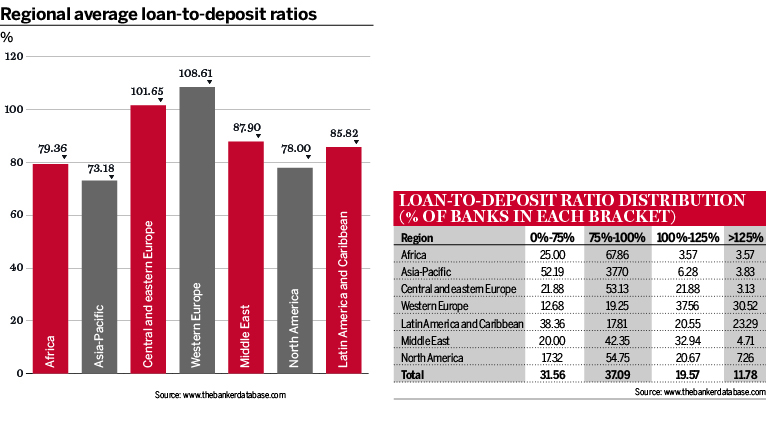Loan-to-deposit (LTD) ratios, a common yardstick for measuring bank liquidity, have continued to fall in this year’s Top 1000 World Banks rankings. The aim is to find a happy medium between a high LTD ratio, which suggests a bank may struggle to cover unforeseen needs, and a low ratio, which indicates it may not be making the most of its deposit base.
The biggest regional drop in LTD ratios is in Latin America and the Caribbean, where the aggregate has fallen by more than 28 percentage points to 85.82%. This is followed by western Europe, which dropped from 120.37% to 108.61%, a ratio lower than two years ago. Nonetheless, its LTD figure is still 7 percentage points higher than any other region.
Central and eastern Europe witnessed an even bigger decline, but the region is still second in the regional rankings. By contrast, there was relatively little movement in Africa, which saw a modest fall to 79.36%.
There were three regions to buck the downward global trend, however. Asia-Pacific’s aggregate LTD ratio has increased to 73.18%, while North America’s has moved up to 78%. The Middle East saw the biggest rise – 6.94 percentage points – but this is perhaps a smaller increase than some expected.
Early last year, analysts warned that Middle Eastern government deposits could drastically shrink as a result of lower revenues caused by collapsing oil prices. As sovereigns and their related entities account for 15% to 35% of deposits at Gulf Co-operation Council banks, according Standard & Poor’s, the consequences could have been dire. But regional deposits dwindled just 5.6% over 2016, allaying fears of a liquidity crunch.
In terms of LTD distribution ratios, there was little change in the overall figures. More than two-thirds of the world’s biggest 1000 banks sit in the 75% to 100% bracket, while the number with ratios in excess of 125% fell by 0.53 percentage points. However, this relatively static picture at the global level masks some quite dramatic swings within individual regions.
The disparity among central and eastern European banks reduced in 2016. More than 10% of the region’s banks have leapt out of the 0% to 75% bracket while the proportion with LTD ratios of 125% or more has nearly halved. North America experienced a similar dynamic. It registered a big fall in the 0% to 75% category, from 30.46% to 17.32%, while the number of banks in the highest bracket shrunk by a similar proportion. More than half the North American banks in the Top 1000 now have LTD ratios between 75% and 100%.
The proportion of western European banks in the lower two brackets has halved since the 2015 rankings, leading to a surge in the number with ratios above 100%. This is at odds with the region-wide drop, which suggests that LTDs are growing at small and medium-sized lenders.
The Middle East’s rising LTD ratio has been caused by banks leaving the 0% to 75% bracket and moving up to the 75% to 125% bracket. Contrary to the regional trend, the number in the 125%-plus bracket has shrunk by nearly 3 percentage points. This suggests that no individual banks have been hit by big deposit withdrawals.
Africa, meanwhile, saw some dramatic changes, with an exodus of banks from the 100% to 125% category and a rush into the 75% to 100% category. This is consistent with the regional downward trend.





